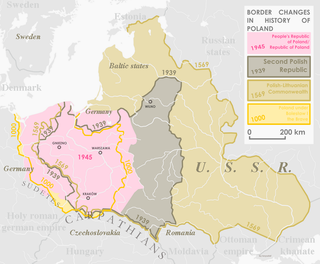 Global Information
Global InformationPolonization information
This article is about an event or subject that is ongoing but the article covers only the subject and events until the year 1947. |
 Poland's and the Commonwealth's historical borders | |
| Duration | 1569–1945 |
|---|---|
| Location | Poland throughout history |
| Borders | Yellow – 1000 Khaki – 1569 Silver – 1939 Pink – 1945 |
Polonization or Polonisation (Polish: polonizacja)[1] is the acquisition or imposition of elements of Polish culture, in particular the Polish language. This happened in some historic periods among non-Polish populations in territories controlled by or substantially under the influence of Poland.
Like other examples of cultural assimilation, Polonization could be either voluntary or forced. It was most visible in territories where the Polish language or culture was dominant or where their adoption could result in increased prestige or social status, as was the case with the nobilities of Ruthenia and Lithuania. To a certain extent, political authorities have administratively promoted Polonization, particularly during the Second Polish Republic and in the period following World War II.
Polonization can be seen as an example of cultural assimilation. Such a view is widely considered applicable to the times of the Polish–Lithuanian Commonwealth (1569–1795), when the Ruthenian and Lithuanian upper classes were drawn towards Westernization with the adoption of Polish culture and the political and financial benefits of such a transition, as well as, sometimes, by the administrative pressure exerted on their own cultural institutions, primarily the Orthodox Church. Conversion to the Roman Catholic (and, to a lesser extent, Protestant) faith was often the single most important part of the process. For Ruthenians at that time, being Polish culturally and Roman Catholic by religion was almost the same. This diminishing of the Orthodox Church was the part most resented by the Belarusian and Ukrainian masses. In contrast, the Lithuanians, who were mostly Catholic, were in danger of losing their cultural identity as a nation, but that was not realized by the wide masses of Lithuanians until the Lithuanian national renaissance in the middle of the 19th century.
On the other hand, the Polonization policies of the Polish government in the interwar years of the 20th century were again twofold. Some of them were similar to the mostly forcible assimilationist policies implemented by other European powers that have aspired to regional dominance (e.g., Germanization, Russification), while others resembled policies carried out by countries aiming at increasing the role of their native language and culture in their own societies (e.g., Magyarization, Rumanization, Ukrainization). For Poles, it was a process of rebuilding Polish national identity and reclaiming Polish heritage, including the fields of education, religion, infrastructure and administration, that suffered under the prolonged foreign occupation by the neighboring empires of Russia, Prussia, and Austria-Hungary. However, as a third of recreated Poland's population was ethnically non-Polish and many felt their own nationhood aspirations thwarted specifically by Poland, large segments of this population resisted to varying degrees the policies intended to assimilate them. Part of the country's leadership emphasized the need for the long-term ethnic and cultural homogeneity of the state. However, the promotion of the Polish language in administration, public life and especially education, were perceived by some as an attempt at forcible homogenization. In areas inhabited by ethnic Ukrainians, for example, actions of the Polish authorities seen as aiming at restricting the influence of the Orthodox and the Ukrainian Greek Catholic Church caused additional resentment and were considered to be closely tied to religious Polonization.
- ^ In Polish historiography, particularly pre-WWII (e.g., L. Wasilewski. As noted in Смалянчук А. Ф. (Smalyanchuk 2001) Паміж краёвасцю і нацыянальнай ідэяй. Польскі рух на беларускіх і літоўскіх землях. 1864–1917 г. / Пад рэд. С. Куль-Сяльверставай. – Гродна: ГрДУ, 2001. – 322 с. ISBN 978-5-94716-036-9 (2004). Pp.24, 28.), an additional distinction between the Polonization (Polish: polonizacja) and self-Polonization (Polish: polszczenie się) has been being made, however, most modern Polish researchers do not use the term polszczenie się.